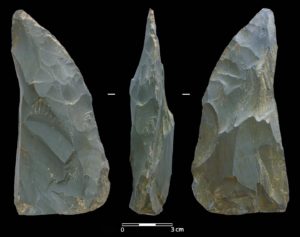
PROCEEDINGS OF THE NATIONAL ACADEMY OF SCIENCES—A study examines the dispersal of Neanderthals into Siberia. Neanderthals once populated Europe and Asia, spreading as far east as southern Siberia. Chagyrskaya Cave, located in the foothills of Siberia’s Altai Mountains, has yielded 74 Neanderthal fossils and thousands of stone artifacts and animal and plant remains dating to between 59,000 and 49,000 years ago. Kseniya Kolobova, Richard Roberts, and colleagues analyzed more than 3,000 stone tools from Chagyrskaya Cave and discovered that the tools closely resemble Micoquian tools made by Neanderthals in eastern Europe, more than 3,000 km west of Chagyrskaya Cave. Environmental reconstructions based on ancient fauna and flora suggest that Chagyrskaya Neanderthals hunted bison and were adapted to the cold and dry climate. However, the nearby site of Denisova Cave, which was occupied by Neanderthals more than 100,000 years ago, exhibited no evidence of Micoquian artifacts. DNA from a Chagyrskaya Neanderthal also indicated a closer connection with eastern European Neanderthals than with a 110,000 year-old Neanderthal from Denisova Cave. The findings suggest at least two separate dispersals of Neanderthals into southern Siberia, with the most recent arrivals carrying Micoquian tools from their ancestral homeland in eastern Europe, according to the authors.
_____________________________

Stone tool used as a meat knife by Neanderthals at Chagyrskaya Cave (Altai Mountains, southern Siberia, Russia) around 54,000 years ago. Alexander Fedorchenko (Russian Academy of Sciences, Novosibirsk, Russia).
_____________________________
Article Source: A PNAS news release
*”Archaeological evidence for two separate dispersals of Neanderthals into southern Siberia,” by Kseniya A. Kolobova et al.
_____________________________
Advertisement





